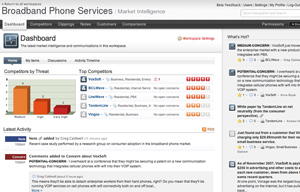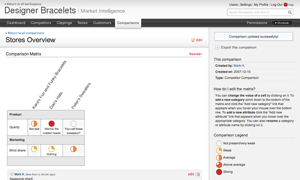In December 2006, we reviewed a product called Competitious that helps businesses keep track of competitors by aggregating website traffic data and blog posts about them. Today, the same company behind Competitious has released a new on-demand service called RivalMap that means to take the tracking and management of competitors to the next level.
RivalMap reminds me of BaseCamp in part because both products are based on Ruby on Rails and contain many user interface similarities. More importantly, they are both collaboration tools, with BaseCamp meant for virtually any type of collaboration and RivalMap intended for a particular use: the keeping tabs on one’s competitors.
Every company registered with RivalMap receives a project area with a subdomain (e.g. http://techcrunch.rivalmap.com/). Registered employees can sign into these project areas to share information and thoughts about their rivals in a variety of forms: wiki-fied company profiles, website clippings, general notes, customer profiles, and comparison charts to name a few. Other employees can then respond to these contributions by leaving comments, “starring” notable content (which then causes that content to rise a la Digg), and simply editing existing content (say, to update a comparison chart). Contributions are categorized in a variety of ways (under particular competitors or “workspaces”, for example) and all activity on the site can be tracked from a Dashboard page.
All in all, the service is very well-designed with tagging, search, and Ajax used effectively to create a more efficient experience. It seems to me as though the success of the product will now rely on the demand for such a particular type of collaboration tool, given that the idea has been executed very well. The only thing I found lacking is “preloaded” information about competitors. Whereas Competitious pulls in traffic and blog data, RivalMap does not do so…at least yet: the company assures me that it will have “robust” traffic data either from Compete or Quantcast eventually. And rather than pulling in blog headlines from Google, as done by Competitious, a “collaborative RSS dashboard” will also be available before long.
If you want to give RivalMap a spin – or use it with 3 or fewer people – you can do so for free. However, you’ll have to pay a premium of $50/month for 5 user accounts, $100/month for 10, and $200/month for 25. Companies with a desire for more than 25 user accounts will need to contact RivalMap’s sales department.
For a social network’s effort to help employees stay abreast of competitors, read about LinkedIn’s recent news aggregation feature.


